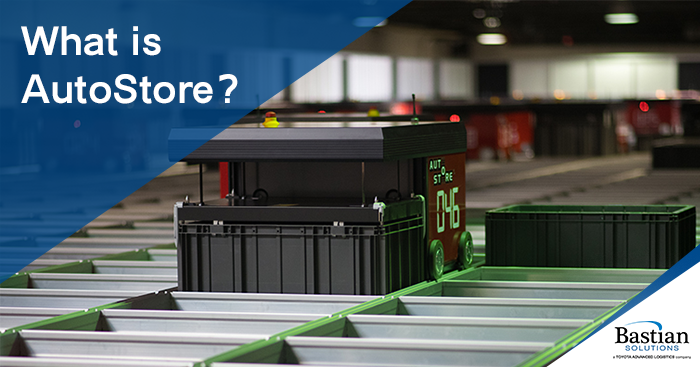
What is AutoStore?
Ryan Nicholas | 04 June 2019
AutoStore is a goods-to-person automated storage and retrieval system that is the market leader in storage density. The idea evolved from the concept of the Rubix Cube. Instead of using standard shelving to store product in a warehouse and wasting all the air space, the “Rubix Cube” concept was generated to create a cube-based storage solution – hence the slogan “Stop airhousing, start warehousing”. This design allows bins of products to be stacked on top of each other in a condensed grid-style system, increasing storage capacity up to 4 times in the same footprint and performance up to 10 times without added workers.

The Key Aspects of AutoStore:
- Highest density storage solution on the market
- Up-time average of 99.6%
- Based on the Pareto principle, the system allows for natural slotting
- Energy efficient
- Able to be fit to any shape building
- No single point of failure
- Products are secure from the outside and can only be accessed through ports
- 24/7 operation
- Ability to expand system without stopping operations

Components of the AutoStore System
The Grid:
This is the framework for the AutoStore system. It consists of lightweight aluminum profiles making it flexible to design and easy to install. This framework is the housing for all the storage within the system. The grid consists of columns that make up the “cells” of the system, with each “cell” representing a location on the XY-axis and containing multiple stacked bins. Not only is the grid the framework of the system, the upper layer is also the railway for the robots to travel.
The Ports:
These are the workstations where the robots deliver and retrieve bins for the operators. Ports can be configured for picking goods, inputting goods, or both. Bins are automatically weighed to ensure they do not exceed the capacity of the system prior to allowing it to enter the system. There are 4 standard port options available to meet your operation’s needs:
- Conveyor Port: max throughput of 240 bins/hour
- Carousel Port: max throughput of 350 bins/hour
- Swing Port: max throughput of 170 bins/hour
- Relay Ports: max throughput of 650 bins/hour
The Robots:
The hardest workers in the AutoStore system are the robots. Consisting of 8 wheels for 4-directions of travel, lifting mechanisms to lift and lower bins in and out of the system, and no need for rest; these robots can work continuously. They are tasked with delivering bins to and from cell/port locations, task preparation, cleanup tasks, and the ability to prepare the system during downtime hours to ensure maximum efficiency during operation.
 The original R5 Robot:
The original R5 Robot:
 The new B1 Robot:
The new B1 Robot:
AutoStore Design Engineering Considerations
When considering implementing an AutoStore system into a facility there are quite a few things to consider. Let’s start with what is needed to get a base design concept. First, an end user needs to evaluate the company goals and what they would like to accomplish with this system. Next, decisions need to be made for the space, product, quantity, and rates that are needed to justify that this is the right system for their needs. Below you will find a few key considerations to get started with an AutoStore system:
- Footprint available for the system
- What SKUs will be stored in the system
- The type/size of the product to be stored
- 3 months of customer/sales order data (This will help determine the Pareto Curve)
- Including # of lines per order
- SKUs
- Clearance height of building (this will allow the engineers to determine max height of system)
- Handling time: Time it takes to handle each bin at a workstation
- Rates that need to be achieved for in-bound & out-bound product
If space, security, organization, inventory management, and need to run are all a problem in your organization and efficiency, throughput, and success is your goal, then AutoStore may be the solution for you. A company with a Pareto ratio of 80:20, where 80% of orders are completed from 20% of the product, is the golden egg for an AutoStore system.
Is the AutoStore Right for You?
This system has allowed top companies to increase throughput, decrease labor needs, combine multiple DCs under a single roof, decrease down time, and achieve ultimate success across the world. E-commerce, industrial, apparel, you name it, the AutoStore system will be changing the game for years to come.
Bastian Solutions is the largest AutoStore integrator in North America, with over 1.4 million bins and over 1850 robots installed. If you’re interested in learning more about the AutoStore system, contact us. We’ll help you determine if it’s a good fit for your order fulfillment operations.
Ryan Nicholas is a Field Applications Engineer for Bastian Solutions in Florida. He has a Bachelors Degree in Mechanical Engineering from the University of Alabama. His experience includes mechanical and industrial design, industrial engineering, ergonomic standards, and time study analysis. He is an avid outdoorsman and loves to spend the weekends on the water.
Comments
No comments have been posted to this Blog Post
Leave a Reply
Your email address will not be published.
Comment
Thank you for your comment.